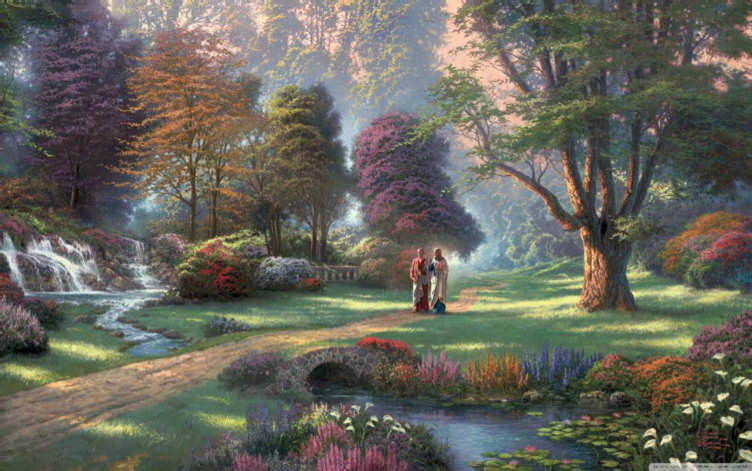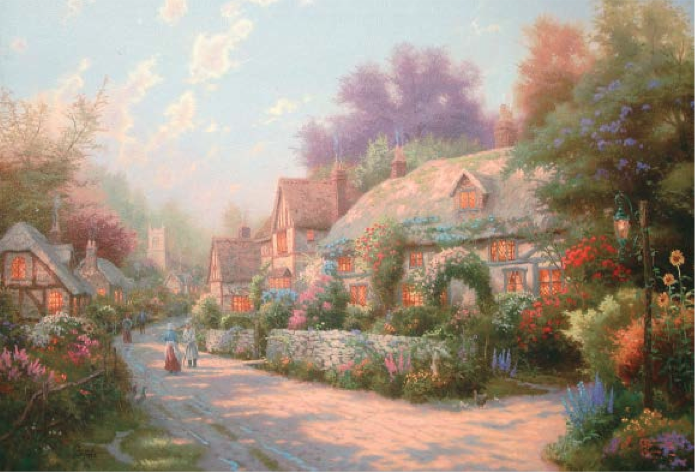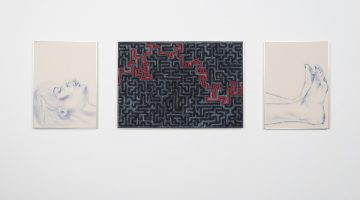The painting shows a cottage, every window brightly lit from an otherwise undepicted interior. Smoke curls from the chimney. A storm runs by, roughly paralleled by an irregular path. The cottage is set near a grove of an oddly mixed species of trees. The path disappears into the trees, and beyond them mountains, only lightly barely indistinct from atmospheric perspective, fill in some of the canvas. All beings may safely graze. Any student of art history can recite precedents from among the masters of pre-twentieth-century European painting for every aspect of the composition, handling, and contents of the picture. The technical ability displayed here forces the word “competent” to one’s lips. How can such a work induce any strong response, indeed the universal scorn of the art world?
Nearly 50 years ago the anthropologist Mary Douglas argued that a culture can be fruitfully studied by considering how it polices its boundaries. At the edge of a culture stands an indeterminately vast array of monsters: the beings who embody what we don’t do, don’t say, don’t eat, or don’t touch. Monsters at the boundaries arouse disgust in those within the culture. One of Douglas’s distinctive claims is that a monster is something that exhibits a cognitive dissonance, in that the monsters seem simultaneously to exemplify for a culture categories that ought to be kept separate. Douglas’s most spectacular analysis illuminates the system of classifications that underlie the seemingly arbitrary catalog of abominations in Leviticus; for example, the snake is an abomination because that which is on land should walk on legs, not crawl or slither, which are the characteristics of the beasts of the sea.
Besides illuminating something of the classificatory structure of a society, the consideration of monsters reveals something about the society’s relative willingness or resistance to re-structuring itself by its attitude towards cognitive dissonance. Douglas extends this kind of analysis into modern institutions, such as the army, which are partially characterized by the degree of internal structuring, hierarchy, and relative porosity of their boundaries. As Douglas later summarized the analyses, “each tribe actively construes its particular universe in the course of an internal dialogue about law and order.”1
On first thought the art world might not seem amenable to such an approach. Even if one can speak of our diffuse, polycentric, and global art world as an institution, its self-conception and the characterization of its contents, structure, and modes of authority would appear peculiarly impervious to analysis; allegedly anything can be a work of art, anyone can make an artwork, and evaluations are individual and ineliminably subjective. Lacking even the most porous boundaries, the art world would also lack the motivation to engage in an internal dialogue about its limits. But there is one great monster among recent artists, someone whose work seems outside of what anyone inside the art world can treat as even a candidate for seriousness: the self-described “painter of light,” Thomas Kinkade, whose works, such as the one described above, have allegedly graced one in twenty American homes in the past two decades. No obituary by a prominent art critic following Kinkade’s alcohol-and-drug-induced death two years ago suggested the possibility of a post-humous re-evaluation and rehabilitation of Kinkade’s work, even to the small extent that Norman Rockwell’s has recently undergone. Instead, facts are recited, with the combination of repetition, lack of explication, and lack of evidence suggestive of a social myth being rehearsed: Kinkade was the “most popular” artist of recent time; his work was loved by the common folk; many collectors began and ended their days with a good look at a Kinkade; rejecting modernism and “ugliness,” Kinkade wished to provide beauty and solace. On the other hand the art world condemned the work as either sentimental or kitsch. Perhaps as important as these particular admonitions is the qualification that the works are pure: “pure” kitsch, that is. What one does not find, then or before, is any account of Kinkade’s work as art. It is neither clear what particular qualities are being grouped under these negative terms, nor is there any reflection on why sentimentality and kitsch are uniquely problematic in contemporary art.

Thomas Kinkade, Walk of Faith, 2011. Courtesy of the Internet.
There is a history of vices and so too of what counts as monstrous. A central vice in modernist painting was “the decorative.” A painting might be condemned as decorative either by failing to generate a sufficient rich meaningfulness (a constant worry of Kandinsky’s with his abstract painting), or by ‘merely’ illustrating some text, and gaining its meaning only via relations external to the painting. The withering and near-extinction in contemporary art of the term “decorative” as a negative term would then be the result of the developments out of minimalism that treat the external condition of an art work—the architectural environment, the activity of the viewer, the institutional structure, the ideological framing—as constitutive elements of a work. By contrast the terms “sentimental” and “kitsch” maintain their sting from the days of modernism when Oscar Wilde lambasted sentimentality as trafficking in unearned affect, and Hermann Broch and Clement Greenberg treated the latter as the mark of ersatz and cliché-ridden cultural products. It is with these abominations that the monster Kinkade is kept outside the gates, and simultaneously the sentimental and the kitschy provide what little there is in contemporary art as consensual marks of failure.
A further and less secure part of the social myth of Kinkade is that he was America’s “most controversial” artist. One is supposed to think that Kinkade’s work is the very icon of the yearning masses, hungry for beauty, meaning, and solace, and that the power of this work presents a challenge to art world orthodoxy. Now the fact, if it is one, that many people have bought and adore Kinkade’s products (not just or even primarily paintings, but prints, and then endless products festooned with the images or Kinkade’s name: the expected gewgaws, plates, and teapots, but also paddles and watches) might be thought no more of a challenge to the discourse of art than the widespread consumption of fast food is to the practice of cooking. But the works do provide the opportunity for reflecting on the limits of seriousness in contemporary art, and whether too there might be elements in Kinkade’s work that could be taken up and put to uses other than Kinkade’s.
It is startling to learn that as a teenager Kinkade apprenticed himself to his next-door neighbor Glenn Wessels, a former student of Hans Hofmann’s who regaled him with stories of Gertrude Stein and Ezra Pound from days of modernist yore. Around the age of twenty, while attending art school in Pasadena, Kinkade rejected modernism, or at least one of its most objectionable yet durable inheritances from romanticism that survives until today as a kind of artistic common sense—namely the idea that a work of art is first of all an instance of an artist’s self-expression, particularly of her mental states, attitudes, moods, and emotions. What replaced this was a conception of art as a “service” to its audience. Kinkade seemed to conceptualize the audience and its needs and interests in ways that largely overlap Immanuel Kant’s views of the moral situation of the run of humanity in the famous opening chapter of Groundwork to the Metaphysics of Morals. Both think ordinary people are decent, possessed of a secure sense of right and wrong, and have some access to the source and principle of moral values. For both something like the characteristics of modern life trouble, but do not destroy, the moral orientation of ordinary people. For Kant, drawing upon Rousseau’s account of amour-propre, the problem was the tendency to overrate “his majesty the ego,” and to be tempted to except oneself from the demands of morality. The appropriate philosophical response to the temptation was to show that such self-exemption was unsustainable, and that the desire to avoid morality duties could be checked by the sublime view of oneself as the very author of the moral demands that one considered avoiding. For Kinkade, modern life introduced a chaos of ugliness into the world; the remedy would be an art of solace, one which at each point offered the viewer a path out of modern life into a world saturated with the source of goodness. In a venerable Christian tradition stretching back at least to Pseudo-Dionysius the Areopagite in the early seventh century, Kinkade identified the source of goodness as God, and the this-worldly and visible expression of this goodness as light. The demand for a contemporary painter of light was born out of an insight into the emptiness of a central modernist myth.
Part of the social myth of Kinkade connects the rejection of self-expression in art to a religious vision. While in class with a nude model, Kinkade was struck by a vision of the face of Jesus and painted it in His guise as Man of Peace. The resultant work looks like a student’s fumbling reminiscence of Titian’s Ecce Homo. The narrative staging of the revelation is more telling in its near-repetition of a founding moment of contemporary art, when in the late 1940s the student painter Robert Rauschenberg turned from a model and covered a canvas with numbers smudged with a dirty white. Leo Steinberg famously diagnosed Rauschenberg’s gesture as part of the beginning of a shift away from the deep-seated conception of a picture-plane as an analogue to the visual field, and towards that of the picture as a kind of work surface, hung vertically but worked horizontally, the “flat-bed” picture plane.2 Instead of this typical postmodern and contemporary conception, Kinkade developed a conception of the picture plane as what he called “the envelope.” In this conception the canvas is treated in the all-over manner descended from Monet: no bit is left unworked, and each part seems to have received precisely the same effort of Kinkade’s attention. The envelope provides both the impression of an overall unity, and the even-treatment of details conveys something of sense that God is in all things, from the major motifs to the details.
On the evidence of the major catalog of a retrospective of Kinkade’s work3, Kinkade’s distinctive conception seems to have been in place by the late 1980s, with refinements into a fully achieved state by the late 1990s. Moonlit Village of (1989) displays the “envelope” in its plausible rendering of a bright moon casting shadows on the snow, but bizarrely shows the sky a pale blue that reaches towards Tiepolo. The windows on the church’s spire are a-characteristically unlit, a pre-stylistic holdover suggesting spiritual emptiness, and which as such will be eliminated in succeeding works. In a typical later piece, Twilight Cottage (1997), the small patch of bluish sky shows a crescent moon and an impossible ten stars of at least second-magnitude, while the ambient light easily distinguishes the blues, reds, purples, and lavenders of flowers. The peculiar mixture of cues indicating direction and intensity of light is matched by the mixture of traditional landscape composition on the model of Claude with some whiffs of a tamed sublime. The landscapes of Claude typically have framing elements of hills, buildings, or especially trees, between which alternating light and dark planes organize spatial recession to a distant horizon or light source. The distance between foreground and the most distant background is traversed by a path, through which the viewer gains imaginative access to the contents of the painting. The Claudian space is fundamentally intelligible and made for human exploration. In the sublime paintings of Salvator Rosa the path is broken or eliminated, and the viewer is confronted with something mightier than herself. Within a fundamentally Claudian conception, Kinkade introduces just enough of the sublime mode to block the viewer’s imagined physical access to the far planes; the pointless meanders of the path give out in some middle-distance hedge or copse. Kinkade’s space is not fundamentally traversable, but rather inhabitable, and this within strict boundaries.
What finally makes the Kinkades so objectionable, so unredeemable for the contemporary art world is first of all this compositional strategy that sacrifices everything suggestive of exploration, anti-rationalism, contingency, and multiple perspectives. Then the choice of elements is governed by the implacable criterion that each bit can be seen as exhibiting the Deus sive Natura as radiant light, while contributing seamlessly to the overall envelope. Despite the Christian context, even the most austere presentation from Paul of the Christian virtues of faith, hope, and charity is here mutilated into a placid faith that is indistinguishable from self-satisfaction. Perhaps the alleged attraction of all this for the audience untouched by the art world arises from the induced desire to enter the painting. The Claudian scheme provides multiple points of entry, and the density of detail provides numerous halting points for the gaze. The lack of elements bridging from detail to envelope discourages the gaze from moving and comparing. This is bound to the insistence that all windows be brightly lit: looking at one is just as rewarding as looking at another, and one is not meant to wonder what sort of life requires such unrelieved illumination.
If this be sentimentality and kitsch, can the art world re-structure itself so as to incorporate something of its attractiveness to those immune to the main lines of contemporary art? The finer analysis of the elements of sentimentality and kitsch is beyond my scope here, but it is interesting that a number of artists have given students the assignment of altering a Kinkade. The painter Chester Arnold told me that he has tasked students with setting the Kinkade cottages ablaze. Others have stuck in figures, monsters in the trees or ghouls peeking out the window. I imagine an added figure representing something of the mood of the poet Georg Trakl’s A Winter Evening: “Wanderer, step silently inside;/pain has petrified the threshold./There in pure radiance/Bread and wine glow upon the table.”4
1) Mary Douglas (1975), Implicit Meanings, London: Routledge & Kegan Paul, p. 5, summarizing (1966), Purity and Danger, London: Routledge & Kegan Paul
2) Leo Steinberg (1972), Other Criteria, Chicago: University of Chicago Press, and (2000).
3) Encounters with Rauschenberg, Chicago: University of Chicago Press.
4) Jeffrey Vallance (2004), Thomas Kinkade: Heaven on Earth, Santa Ana: Grand Central Press
Translation by Jim Doss and Werner Schmidt.



